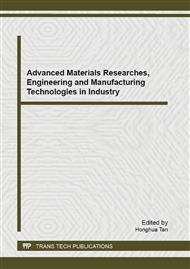[1]
HENG Li. Petri Net as a Formalism to Assist Process Improvement in the Construction Industry [J ]. Automation in Construction, 1998 (7): 349- 356.
DOI: 10.1016/s0926-5805(98)00051-x
Google Scholar
[2]
PROTH J M , MINIS I. Complexity of Production Management in a Petri net Environment [R]. The University of Maryland and Harvard University, (1994).
Google Scholar
[3]
SALIMIFARD K H , WRIGHT M. Petri net - based modeling of workflow systems : An overview[J] . European Journal of Operational Research, 2001 , 134 : 664 - 676.
DOI: 10.1016/s0377-2217(00)00292-7
Google Scholar
[4]
TIAN Feng , LI Renhou , ZHANG Jincheng. Modeling and Analysis of Collaborative Design Activities Using Fuzzy-Timing High-Level Petri Nets [J]. Journal of Computer-Aided Design & Computer Graphics. 2004. 116(13): 267-274 (in Chinese).
Google Scholar
[5]
HUANG Hongzhong , LIU Wei , LI Li. Process Modeling of Product Collaborative Design [J]. Computer Integrated Manufacturing Systems. 2003. 9(11): 955-959 (in Chinese).
Google Scholar
[6]
ALONSO G, HAGEN C, MOHAN C. Enhancing the fault tolerance of workflow manage- ment systems [J] . IEEE Trans on Concurrency , 2000 , 8(3) : 74~81.
DOI: 10.1109/4434.865896
Google Scholar
[7]
TIAN Feng , LI Renhou , HE Bo, et al. Modeling and Analysis of Exception Handling Based on Multi-Agent in Computer Supported Collaborative Design [J]. Journal of Xi'an Jiao Tong University. 2004. 38(4): 392-395 (in Chinese).
Google Scholar
[8]
STINSO P , DOVIS E W, KHUMAWALA B M. Multiple Resource-Constrained Scheduling Using Branch and Bound [J]. AJIE Trans, 1987, 10: 252 - 259.
Google Scholar
[9]
KURBEL Karl, RUPPLE Andreas. Integrating Intelligent Job-Scheduling into a Real-world Production-scheduling System [J]. Journal of Intelligent Manufacturing, 1996, 7: 373 - 377.
DOI: 10.1007/bf00123913
Google Scholar
[10]
SHENG Buyun, Research on Multi-Agent-Based Distributed Decision of Process [D] . Wuhan: Journal of Wuhan University of Technology, 2001 (in Chinese).
Google Scholar
[11]
YUAN Congyi. Petri Nets Theory [M] Beijing : Electronic Industries Press , 1998 (in Chinese).
Google Scholar
[12]
JIANG Zhibing. Petri Nets and the Application in Modeling and Control in Manufacture System. [M] Beijing: China Machine Press, 2004 (in Chinese).
Google Scholar
[13]
VOORHOEVE M , van der Aalst W Ad-hoc workflow : Problems and solutions [A] . Database and In: Proceedings of the 8th International Workshop on Expert Systems Applications, Toulouse, 1997, 36-40.
DOI: 10.1109/dexa.1997.617230
Google Scholar


